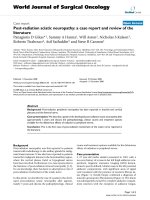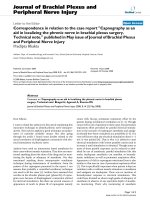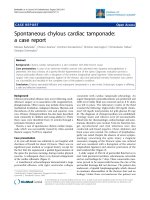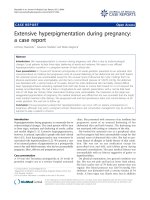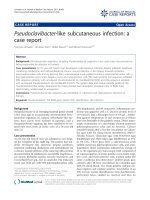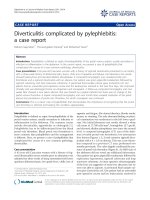Báo cáo y học: "Acute Haemophilus parainfluenzae endocarditis: a case report" pptx
Bạn đang xem bản rút gọn của tài liệu. Xem và tải ngay bản đầy đủ của tài liệu tại đây (284.64 KB, 3 trang )
Case report
Open Access
Acute Haemophilus parainfluenzae endocarditis: a case report
Leonidas Christou
1
, Georgios Economou
1
, Anastasia K Zikou
2
,
Kaiti Saplaoura
1
, Maria I Argyropoulou
2
and Epameinondas V Tsianos
1
*
Addresses:
1
1
st
Department of Internal Medicine and Hepato-Gastroenterology, Medical School, University of Ioannina, Ioannina, 45110, Greece
2
Department of Radiology, Medical School, University of Ioannina, Ioannina, 45110, Greece
Email: EVT* -
* Corresponding author
Received: 20 February 2008 Accepted: 22 January 2009 Published: 16 July 2009
Journal of Medical Case Reports 2009, 3:7494 doi: 10.4076/1752-1947-3-7494
This article is available from: />© 2009 Christou et al; licensee Cases Network Ltd.
This is an Open Access article distributed under the terms of the Creative Commons Attribution License (
/>which permits unrestricted use, distribution, and reproduction in any medium, provided the original work is properly cited.
Abstract
Introduction: Numerous pathogens can cause infective endocarditis, including Haemophi lus
parainfluenzae. H. parainfluenzae is part of the H. aphrophilus, Actinobacillus actinomycetemcomitans,
Cardiobacterium hominis, Eikenella corrodens, and Kingella kingae group that may cause about 3% of the
total endocarditis cases, and is characterized by a subacute course and large vegetations.
Case presentation: Acute H. parainfluenzae endocarditis developed in a 54-year-old woman, with
no underlying predisposing factors. The patient presented with fever of 3 days duration and a severe
headache. Magnetic resonance imaging of the brain revealed multiple cerebral emboli with
hemorrhagic foci. Upon suspicion of endocarditis, cardiac transesophageal ultrasonography was
performed and revealed massive vegetations. The patient underwent emergency mitral valve
replacement, and was further treated with ceftriaxone. Blood cultures grew H. parainfluenzae only
after valve replacement, and a 6-week course of ceftriaxone was prescribed.
Conclusion: We underline the typical presentation of large vegetations in H. parainfluenzae
endocarditis, which are associated with embolic phenomena and resulting severity. Although the
majority of the few cases reported in the literature are subacute in progress, our case further underlines
the possibility that H. parainfluenzae endocarditis may develop rapidly. Thus, awareness of the imaging
characteristics of the pathogen may enhance early appropriate diagnosis and therapeutic response.
Introduction
Although endocarditis is a common severe medical entity
for which guidelines are continuously updated [1], its
etiology can sometimes be vague, implicating rare
pathogens. Some of them have been categorized jointly
as part of the Haemophilus aphrophilus, Actinobacillus
actinomycetemcomitans, Cardiobacterium hominis, Eikenella
corrodens, and Kingella kingae (HACEK) group of rare
bacteria that are responsible for a small, but recognizable
percentage (roughly 3%) of endocarditis cases. They are all
Gram-negative bacteria belonging to the oropharyngeal
microflora, and are slow-growing; their growth is enhanced
by the presence of carbon dioxide [2]. Various Haemophilus
species have been implicated in the etiopathogenesis of
Page 1 of 3
(page number not for citation purposes)
endocarditis, including H. influenzae, H. aphrophilus,
H. paraphrophilus,andH. parainfluenzae.Ofthese,
H. aphrophilus is the most common pathogen in endocardi-
tis [3], followed by H. parainfluenzae [4]. We describe a
patient with H. parainfluenzae endocarditis that followed an
acute course and highlight some of the most important
characteristics of this rare, but significant, entity.
Case presentation
A 54-year-old, Greek woman was admitted to our Internal
Medicine Department with a high-spiking fever accom-
panied by rigor. She also complained of myalgias and sore
throat. The symptoms started 3 days earlier. A few hours
before admission, a severe headache started and led her to
seek medical advice.
Her medical history was not significant. She did not report
any visits to the dentist or any dental-related disease in the
recent past. She had not undergone any invasive endo-
scopic procedure, nor had she exhibited any symptomatol-
ogy in the weeks before her admission. She was not
immunocompromised and did not regularly take any
medications. On clinical examination, her temperature was
39.5
0
C, and her blood pressure normal. There were no
clinical indications of active pulmonary or cardiac involve-
ment, and a brief neurological examination detected no
abnormalities. Nuchal rigidity was absent. A laboratory
examination revealed anemia (hemoglobin 11 g/dL), and
increased erythrocyte sedimentation rate (72 mm/hour)
and C-reactive protein (321 mg/L). During paraclinical
work-up, the patient developed multiple purpural lesions
on her legs. There was no nail hemorrhage or petechial
lesions on her soles or palms on clinical examination.
Multiple cultures were draw n and a brain computed
tomography (CT) scan was performed. Its findings were
further assessed by magnetic resonance imaging (MRI),
which revealed (Figure 1) multiple cerebellar, white matter,
and sub-grey matter, low-signal T1-weighted and high-
signal T2-weighted lesions. Some of these lesions exhibited
no-signal T2-weighted areas, consistent with a hemorrhage.
Immediately following the MRI results, and upon strong
suspicion of endocarditis leading to cerebral emboliza-
tion, transesophageal echocardiography was performed,
revealing two 20 mm mitral valve vegetations.
The patient was started on ceftriaxone, 2 g intravenously
b.i.d. and vancomycin, 500 mg intravenously q.i.d., and
mitral valve replacement surgery was performed later that
day, embolization being an indication for valve replace-
ment in infective endocarditis in the case of large
Figure 1. Axial T1(A) and T2(B)-weighted images through the cerebellar hemispheres demonstrate multiple infarctions
(white and black arrows).
Page 2 of 3
(page number not for citation purposes)
Journal of Medical Case Reports 2009, 3:7494 />vegetations such as the ones present in this patient [5].
Following valve replacement, antibiotic ther apy was
continued.
Four days after the valve replacement, blood cultures were
positive for H. parainfluenzae. Throat swab specimens were
cultured after the initiation of antimicrobial therapy and
were negative as expected. The strain was susceptible to a
variety of antibacterials, including amoxicillin-clavulanate.
A decision was made to continue on ceftriaxone though,
while vancomycin was discontinued. Ceftriaxone was
administered, uneventfully, for six more weeks, together
with gradual initiation of warfarin therapy.
Discussion
A recent review found that less than 70 cases of H.
parainfluenzae endocarditis have been reported in the
literature, and the typical clinical pattern is that of a
subacute endocarditis, developing after dental procedures
in patients with pre-existing valvular disease, and carrying
significant mortality (10% to 35%) [4]. However, an older
review of new and historical cases found that, surprisingly
for a bacterium of low pathogenicity in general, the
majority of cases reported also had no predisposing factors
for endocarditis development [6]. As in our patient, the
mitral valve is a common site of infection, and vegetations
tend to be large, again as in our patient. Early reports
suggested an adverse correlation between vegetation size
and outcome [7]. The size of the vegetations is further
responsible for the tendency for occlusive disease asso-
ciated with H. parainfluenzae endocarditis [8].
In our patient, the evolution of endocarditis was acute: she
was retrospectively questioned for any potential symp-
toms that would prove a mild, subacute disease form (one
that would also be consistent with the vegetations' size),
but she did not recall any symptoms apart from ill-defined
malaise. The patient was theoretically free of previous
heart disease, and had not undergone any invasive, dental
or other procedure. Thus, the probable scenario would be
that of an acute endocarditis developing rapidly over the
course of an acute pharyngeal infection. The patient was
later evaluated for the presence of any immune defects that
would partially explain her disease, but no such defect was
found.
Another scenario would be that H. parainfluenzae was an
innocent bystander, a pure pharyngeal infection that
coincided with endocarditis due to another pathogen.
This hypothesis could be justified on the basis that 10% of
reported H. parainfluenzae endocarditis cases were poly-
microbial in origin [4,6]. Yet, the presence of bacteremia
and the absence of any other isolated pathogens rule
against such a scenario.
Conclusions
In summary, H. parainfluenzae is a rare, but significant
cause of endocarditis, that may even be culture-negative if
not actively sought after. The pathogen is a ’slow-grower,
as in our patient, and may need specialized media and a
high index of clinical suspicion. H. parainfluenzae endo-
carditis often causes peripheral occlusive disease due to its
tendency for large vegetations; however, these may also be
encountered in acute endocarditis.
Abbreviations
CT, computed tomography; HACEK, Haemophilus aphro-
philus, Actinobacillus actinomycetemcomitans, Cardiobacter-
ium hominis, Eikenella corrodens, and Kingella kingae; MRI,
magnetic resonance imaging.
Consent
Written informed consent was obtained from the patient
for publication of this case report and any accompanying
images. A copy of the written consent is available for
review by the Editor-in-Chief of this journal.
Competing interests
The authors declare that they have no competing interests.
Authors’ contributions
LC, GE, KS, and EVT were the physicians in charge of the
patient throughout hospitalization and follow-up. AKZ
and MIA were responsible for performing, diagnosing, and
discussing the imaging studies of the patient. LC prepared
the manuscript draft, which was critically revised by MIA
and EVT, and approved by all authors.
References
1. Paul-Ehrlich-Gesellschaft fur Chemotherapie (PEG; Paul-Ehrlich-
Society for Chemotherapy); Deutsche Gesellschaft fur Kardiologie,
Herz- und Kreislaufforschung (DGK; German Society for Cardiology,
Heart, and Circulatory Research): German guidelines for the
diagnosis and management of infective endocarditis. Int J
Antimicrob Agents 2007, 29:643-657.
2. Das M, Badley AD, Cockerill FR, Steckelberg JM, Wilson WR:
Infective endocarditis caused by HACEK microorganisms.
Annu Rev Med 1997, 48:25-33.
3. Darras-Joly C, Lortholary O, Mainardi JL, Etienne J, Guillevin L, Acar J:
Haemophilus endocarditis: report of 42 cases in adults and
review. Haemophilus Endocarditis Study Group. Clin Infect Dis
1997, 24:1087-1094.
4. Brouqui P, Raoult D: Endocarditis due to rare and fastidious
bacteria. Clin Microbiol Rev 2001, 14:177-207.
5. Haldar SM, O’Gara PT: Infective endocarditis: diagnosis and
management. Nat Clin Pract Cardiovasc Med 2006, 3:310-317.
6. Lynn DJ, Kane JG, Parker RH: Haemophilus parainfluenzae and
influenzae endocarditis: a review of forty cases. Medicine
(Baltimore) 1977, 56:115-128.
7. Blair DC, Walker W, Sodeman T, Pagano T: Bacterial endocarditis
due to Haemophilus parainfluenzae. Chest 1977, 71:146-149.
8. Ho HH, Cheung CW, Yeung CK: Septic peripheral embolization
from Haemophilus parainfluenzae endocarditis. Eur Heart J
2006, 27:1009.
Page 3 of 3
(page number not for citation purposes)
Journal of Medical Case Reports 2009, 3:7494 />


